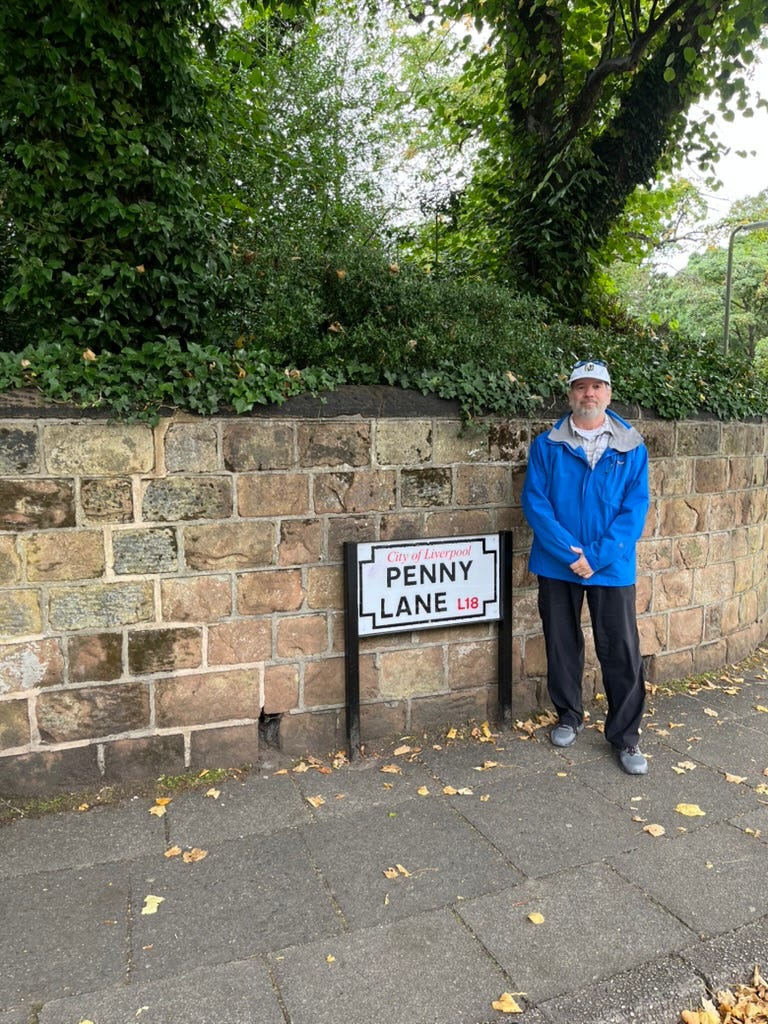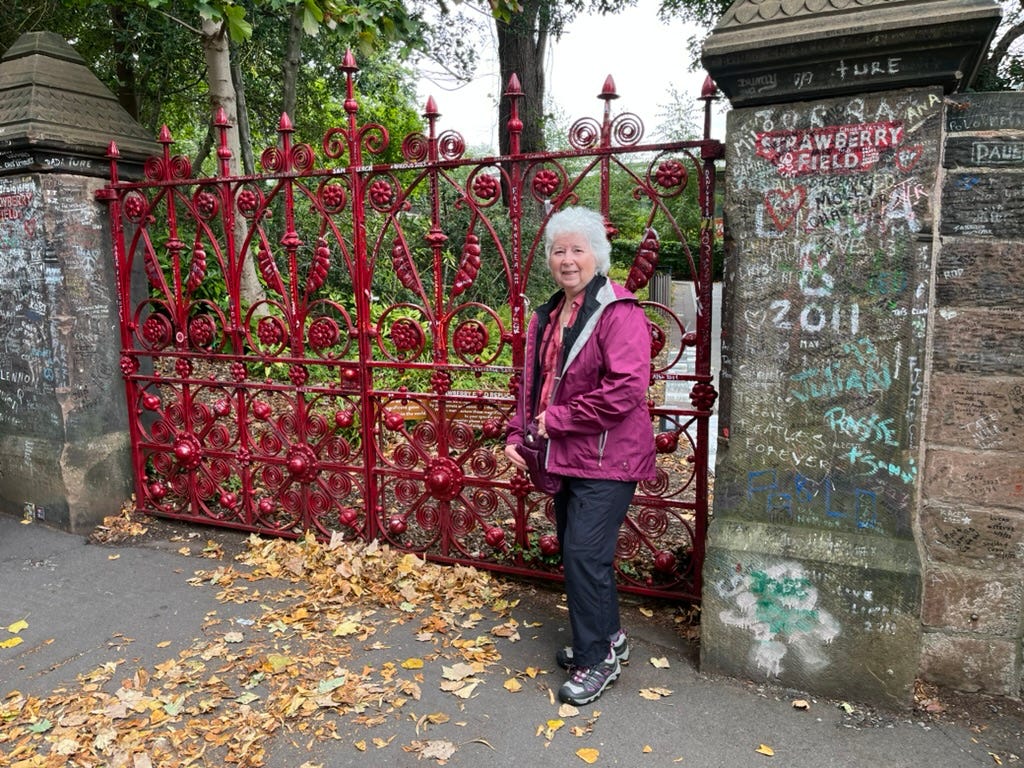Beatlemania Then and Now
Yes, inevitably, I was one of those American kids swept up in Beatlemania when the band appeared on The Ed Sullivan Show in February, 1964. My oldest sister, Ellen, had played their single “I Want To Hold Your Hand” repeatedly on our portable record player and so the six children in our household had The Beatles’ sound in our ears. And, yes, we’d seen many photos of them in fan magazines. But what did they look like in motion? How did they actually perform those corny but jumpy lyrics?
And so the six of us, joined by our skeptical mother, gathered around the black-and- white TV1 in our living room and took it all in. I was probably more struck by the overwrought, screaming teenaged girls than the Fab Four (I was all of seven years old). But okay, the guy on the right side of the stage looking straight into the camera seems the band leader and co-singer, and the skinny, animated guitarist on the left shares the vocal lead, and the guitarist in the middle looks like he’s having fun, and the funny-looking drummer seems to want to sing too but he doesn’t have a microphone (revealing, I guess, that he doesn’t have a good voice).
My mother remained, if anything, even more skeptical after the performance. She contrasted their flat, off-key singing with her hero, Ella Fitzgerald, but who wouldn’t suffer by comparison with one of the greatest voices in American pop history? She also found their longish hair and gyrations off-putting. I should add that Mom never cottoned to Elvis Presley either.
As for her children, ranging in age from six to thirteen, what did we make of it all? When Ellen bought singles she seemed especially drawn to Beatles numbers. When my oldest brother got to choose a “bonus gift” for good sales on his paper route, he selected a weird-looking Beatle wig that we took turns wearing, transforming it into a stringy, mangled thing. When we wanted to get under our conservative father’s skin, we’d assert our affection for the Mop Tops. He reacted by throwing The Beatles wig in the trash can.
For all that, I didn’t really fall in love with their music until I heard “Yesterday” emanating from my transistor radio one quiet evening in my upstairs bedroom. Music didn’t often pull me up short the way it spoke to my brothers and sisters, but I distinctly recall stopping and really listening to Paul McCartney’s ballad of regret. (I must have been a pretty melancholy kid.) That epiphany set the pattern of my relationship with The Beatles: Paul has always been my favorite. I was taken with his Irish good looks, his seeming affability, his dynamic performances on the bass, his wide-ranging tenor, his infectious energy on upbeat tunes, and, of course, his left-handedness (lefties gotta stick together). That fixation culminated in my claiming “Paul” as my confirmation name during my fourteenth year, though I told our supervising priest that I took the name from St. Paul, famous for his epistles.
Like most American kids coming of age in the mid- to late Sixties, Beatles songs pretty much dominated my listening, though my attraction to their tunes varied widely. “Taxman” made little sense to me, and several songs on “Sgt. Pepper’s Lonely Hearts Club Band” were strange beyond my understanding. On the other hand, “Penny Lane,” “A Little Help from My Friends,” and “Get Back” worked their magic. Only later, as I approached my twenties, did I resonate to their heavier, more complex songs such as “While My Guitar Gently Weeps” and “The Long and Winding Road.”
When the group broke up in 1970 I was as bereft as any fan, puzzled that a band so central to my sonic youth could suddenly cease to exist. It really did feel like a death in the family and, in my fevered teenage mind, the end of innocence.
All these memories came flooding back recently as I listened to a new book about the lead songwriters’ relationship, John & Paul: A Love Story in Songs by Ian Leslie. Since John Lennon’s scabrous Rolling Stone interview the year of their breakup asserting his genius and McCartney’s failures of character and talent, I’ve puzzled over how these mates could drift so far apart. After all, in the interviews they gave during their 1964 tour, The Beatles seemed so much a unit, a modern-day Four Musketeers finishing each other’s sentences with rapier wit. When they performed “All You Need Is Love” or “Hey Jude” live, McCartney and Lennon seemed very much in sync, creating compelling harmonies and reinforcing each other’s sheer cool.
Leslie shows that the fissures that grew in the late 60s had always been there. The two lads, each losing their mothers at an early age and impatient with the protocols of school and respectability, formed a combustible union. Lennon in particular carried a cocky “me against the world” persona that could turn on anyone in proximity. McCartney, while presenting a more respectable and restrained front, boiled with ambition, desire, and musical talent. The forced camaraderie of the band, melded by overlong, drug-fueled gigs in Liverpool and Hamburg, concealed rivalries circulating below the surface.
But as I asserted in an earlier post in this newsletter, those more anti-social, aggressive, even destructive impulses often feed creativity. John and Paul openly competed from the jump, aiming to one-up the other through skill and cleverness. They intimidated each other in surprising ways, for they were as insecure as any artist. Lennon dreaded McCartney’s preternatural ability to foresee the architecture of a nascent song while the younger Beatle learned to absorb Lennon’s sharp, stinging barbs and uncanny lyrical talent.
After getting inside this always fragile, tense creative partnership through Leslie’s thoughtful study, I rewatched Peter Jackson’s Get Back and could appreciate the preternatural link between two musical savants. They often had so much fun replaying old songs, rehearsing new ones, and killing time during the inevitably tedious practice sessions. At the same time I could see their wariness with each other, their caution, their strained efforts to suppress or paper over their rivalry. I sense they brought their new partners, Yoko Ono and Linda Eastman, as buffers against the pain of competition verging on fratricide.
Do I hear The Beatles’ songs differently now that I’ve returned to their creations via Leslie’s nuanced book and Jackson’s documentary? Yes, I hear “through” the melody and the lyrics to the inspiration, strains, doubts, choices, and guesses that make up any human creation. Lennon spoke honestly about wishing he hadn’t followed McCartney’s suggestions for scoring “Strawberry Fields Forever.”2 He wanted his songs to hew more closely to pure rock ‘n roll and so dispense with the heavy production championed by his bandmate and George Martin. Yet we should feel free to disagree with the artist and assert the joint achievement of inventor and collaborator. Touchingly Lennon declared in the Rolling Stone interview that “I Want to Hold Your Hand,” the very song that introduced The Beatles to America and me, was their last joint effort. After that each wrote all-but-complete drafts independently of the other and leaned on the band and the production crew to refine and finish the song.
What lessons can I draw from this hyper-creative partnership and rivalry? I probably could use more friction in my writing, more challenges and digressions and trials and errors. From early in the drafting process I tend to see a clear shape and ending for my texts, whether article- or book-length, and surely that means I skim along the surface of my ideas rather than testing and restarting and even discarding. Perhaps I could also be more playful. Watching McCartney and Lennon noodle around in Get Back reminded me how critical associative free play can be for generating new ideas, new possibilities. And when I solicit feedback from friends, I can be far more open to surprises and push back. The Beatles, including the understandably bored George Harrison, felt they were treated as sidemen by McCartney. All the band members’ defenses were on high alert, waiting for the next slight, the next cut. That’s no way to take in divergent responses to a work-in-progress. That’s no way to get better.
Something else occurred to me as I revisited The Beatles ca. 1969: McCartney’s concept of preparing for a live performance was probably on point for a fracturing group. The proof is in the roof top concert, where John, Paul, George, and Ringo, along with their friend Billy Preston on keyboard, were flat out having a good time. They seemed more united, more focused on each other, less in their own heads during the space of that performance. They seemed to recover, however briefly, the magic of their early Sixties appearances.
Since I’ve retired I rarely give public talks or share my work in public, and that’s a real loss. There’s nothing like experiencing that adrenalin rush of standing before friends and strangers to put words in the air, words that serve as a conductor of ideas. Looking people in the eye as you attempt to articulate often half-formed thoughts compels care and precision and sometimes mistakes and often relief that you’ve made something fit for human consumption. That’s the beauty of the arts and humanities—they’re profoundly human.
Sixty-one years after their disruptive appearance on Ed Sullivan, The Beatles can still surprise and teach me. That’s the definition of a classic.
The same TV on which just two months earlier we’d watched in horror and disbelief John F. Kennedy’s assassination, the reputed assassin’s murder, and the president’s burial.




